If you're moving your diet to a vegetarian diet, or just want to include more vegetarian meals in your weekly meal planning, this is a guide to creating an essential vegetarian pantry with must-have staples.
Having a well-stocked pantry for plant-based meals and vegetarian dishes makes it so much easier when changing your diet, especially for last-minute meals.

Moving your diet to (more) vegetarian starts with a well stocked pantry. It's one of my 15 beginner's tips for going vegetarian. Because let's face it, we don't always have time to create a well-planned meal. Some dinners are more on-the-fly, because that's the kind of day we've had.
As a note, before we get started, this essential pantry is designed for vegetarian diets, but with the exception of the final category, eggs, it's also a great pantry for a plant-based diet of vegan meals.
Jump to:
🤷♀️ What is an essential pantry?
Think of it as a collection of key staples you want to have on hand, so that you can whip up a wide variety of vegetarian meals that you love. And when I say "staples", I mean either shelf-stable food with a long shelf life, or things that last in the refrigerator or freezer for at least 3 months.
Your own personal essential pantry of staples will naturally vary depending on your favorite foods, food allergies, and food sensitivities. But bottom line, I recommend a wide variety of foods that can be used as a main focus of a dish and flavor enhancers to keep your new diet interesting to you and your family.
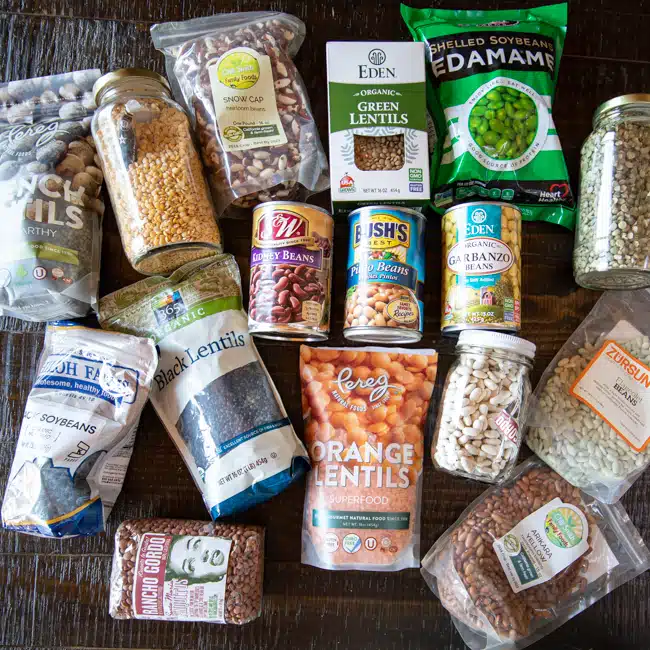
🫘 Beans
This tops most lists for vegetarian and vegan pantries because they provide great protein, fiber, and keep a lot time, whether canned or dried. Additionally, there are literally hundreds of way to use them
I prefer the flavor of beans cooked from dry beans, but it's hard to beat the convenience of canned beans already cooked. Dried beans, however, are a fraction of the cost of canned.
Here are beans I always have on hand, and some uses for them:
Chickpeas: curry, soup, crispy roasted, hummus, salads, sandwich spread, pasta dishes
Black Beans: soup, chili, tacos, salad, casseroles, stuffed peppers, burgers
White Beans: soup, casseroles, salads, hummus
Kidney Beans: chili
Lentils: soup, salads, pilaf, sauces
* Note: I also always have chickpea flour in my pantry, which isn't a bean, but made from chickpeas. I use it often to make farinata and socca (the French equivalent), which I fell in love with on one of my many trips to Italy.
How to Store Dried Beans
Dried beans will last in your pantry for years if stored properly, although the shorter the time they hang around the shelf, the better they are and the faster they cook. For this reason, many of the dried beans I purchase are heirloom beans. For more information on them, read this article on whether heirloom beans are better than regular dried beans.
The best way to store them is in glass jars with screw-on lids. This keeps any pests and bugs from getting into them. I label mine with masking tape and a marker so I can easily identify the jars.
How to Cook Beans
Although the below posts are written for a specific type of bean, the methods described works for any dried bean.
5 Tips for Foolproof Cooked Dried Chickpeas
How To Cook Chickpeas in the Slow Cooker
3 Best Tips for Perfect Instant Pot Black Beans
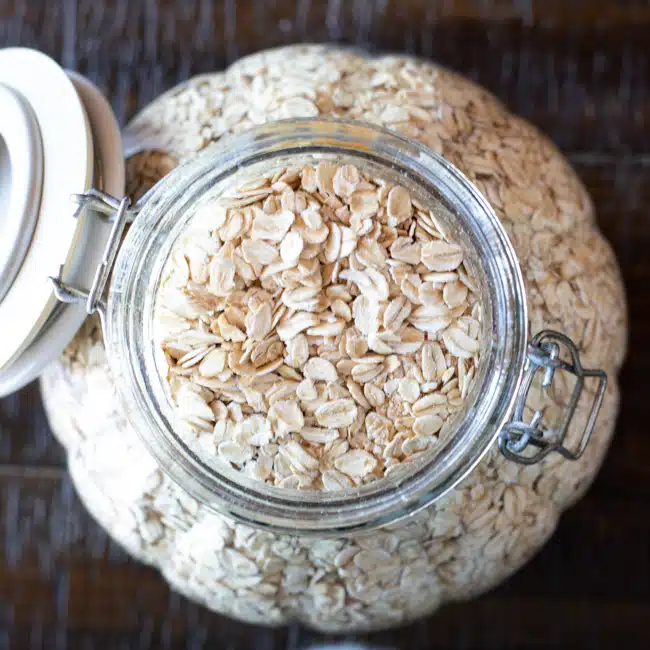
🌾 Grains and Seeds
Whole grains, quinoa and pasta add nutrients, texture and ways to expand dishes like soups and casseroles into a meal. And quinoa specifically adds great protein to dishes.
Grains and seeds also fit into most budgets. The below list are items I almost always have on hand.
White Rice and Brown Rice: soup, stuffed peppers, pilaf, biryani, risotto, salads, bread
Quinoa: salads, fritters, casseroles, stuffed veggies, patties
Barley and Farro: soup, pilaf, salad
Oats: Add to muffins, fruit toppings, rolls, cookies
Pasta: casseroles, mixed with veggies, tossed with greens, with a simple sauce
Chia Seeds: add to yogurt, smoothies, salads, breads, pancakes, jam and whisk into salad dressings
How to Store Grains and Seeds
Just like beans, store grains in glass jars with screw-top lids. I recommend labeling them, and in the case of brown rice, add a date.
The shelf life of most grains, if stored correctly, can extend to years, but brown rice will only last 6 months to 1 year because of the natural oils in its bran layer.
How to Cook Grains and Seeds
How to Cook Fluffy White and Brown Rice
Perfect Fluffy Quinoa (Stovetop) + 5 Quinoa Recipes
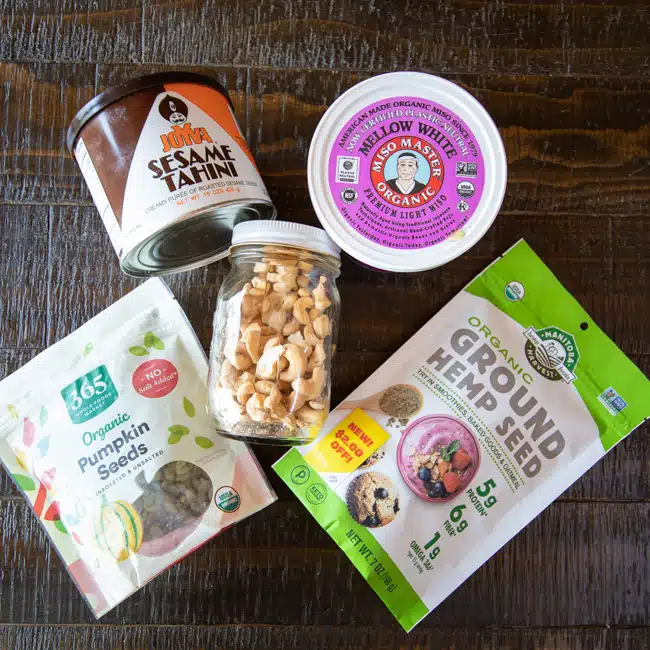
💪 High Nutrient and Protein Boosts
These are ingredients I add to dishes for a boost of protein and nutrients. They are all very different from each other but are excellent tools in your ingredient tool chest when following a vegetarian diet.
Nutritional Yeast: popcorn, veggie chips, and use in place of cheese in soup
Hemp Hearts / Hemp Seeds: salads, casseroles and veggie burgers
Nuts and Nut Butters: some combination of walnuts, pecans, cashews, almonds, pistachios, hazelnuts, peanuts, and pine nuts are great to have around. The nut butters that get the most use are peanut butter and almond butter.
Pumpkin Seeds: I keep a stash of roasted pumpkin seeds (pepitas) in the refrigerator all. the. time for snacking and topping casseroles.
Red and Yellow Miso: red miso is more intense than yellow.
Tahini
Protein Powder and Whey Protein Powder: smoothies, yogurt, and soups
Storage Tips
The bottom is a table for the best ways to store each of the above boosts. The Pantry column assumes your pantry is cool and dark.
If both Pantry and Refrigerate are checked, both ways of storing the ingredient are acceptable, but refrigerating them will extend their shelf life.
| Ingredient | Refrigerator | Pantry |
| Nutritional Yeast | X | X |
| Hemp Hearts | X | |
| Nuts and Nut Butters | X | |
| Pumpkin Seeds | X | X |
| Miso | X | |
| Tahini | X | |
| Protein / Whey Powders | X |

😋 Canned Goods and Flavor Enhancers
I don't keep a lot of canned goods on hand, but I have several that I used in a bazillion recipes. Several of my list of flavor enhancers contribute an umami flavor to dishes.
Canned Tomatoes: I recommend having whole peeled, fire-roasted diced and puréed tomato sauce and strongly recommend San Marzano tomatoes.
Pasta Sauce: keep a couple jars of your favorite on hand for adding to sauces and casseroles, as well as making a quick pasta. My favorite is Rao, but there must be at least 50 kinds now available.
Coconut Milk
Curry Paste: both green and red
Dried Mushrooms
Sun-Dried Tomatoes and my Balsamic Roasted Tomatoes
Better Than Bouillon: there are several vegetarian versions available now. I use the mushroom flavored one when I make my mushroom soup and mushroom risotto, and use the general roasted vegetable base for most everything else.
Vegetable broth: for when you don't want to use the above bouillon product.
Soy Sauce, Tamari, Hoisin Sauce, Enchilada Sauce, Pasta Sauce, Marmite or Vegemite: as a note, if you're new to Marmite and Vegemite, try a just a little start with so you don't overwhelm a dish. Marmite is milder than vegemite.
Olives: both green and kalamata olives (pitted!)
Honey
Herbs and Spices: these will depend on your preferences and the type of food you normally cook. But my personal list includes basil, oregano, thyme, rosemary, fennel, paprika (both hot, sweet and smoked), cinnamon, cumin, curry powder, cayenne, chili powder, and red pepper flakes are always on hand and fresh.
Oils and Vinegars: extra virgin olive oil is a primary oil for me, and avocado oil for air frying or other high-heat applications. I always have coconut oil on hand too. White wine vinegar, apple cider vinegar, sherry wine vinegar, and balsamic vinegar are must-haves at all times IMO.
Dried Fruits: raisins, apricots, cranberries and dates
Capers: these carry a lot of umami, and are great for adding to pasta, egg salad, and chickpea salads.
Maple Syrup: it's not just for pancakes and waffles. Maple syrup is a great general sweetener to add to sweet potatoes and baked beans. Or simmer carrots in a mixture of butter and maple syrup. It's amazing.
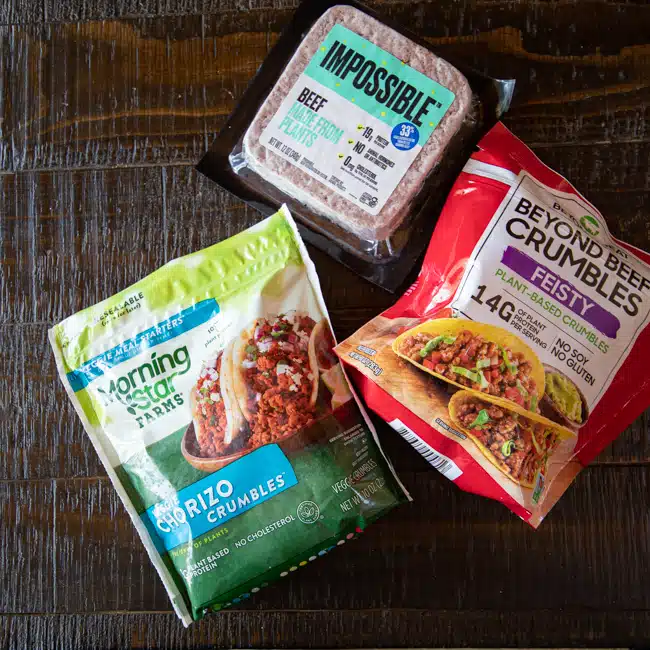
🌱 Plant-Based "Meats"
This category includes meat substitutes and faux meat. These are typically processed foods, and IMO, should be used sparingly. But certainly some are more processed than others (see the below section that describes levels of processed foods.)
I prefer whole foods, but each of these has their place in the kitchen, and I always have some in the freezer to add to dishes. I make "meatballs", and use these products in casseroles, pasta sauce, tamale pies, sloppy joes, chili, and stuffed veggies.
These should always be refrigerated.
Tofu: soy-based and available in various densities.
Seitan: high-protein meat substitute made from vital wheat gluten.
Tempeh: made from cooked and slightly fermented soybeans.
Bio-mimics: plant-based meats that have the appearance of traditional, familiar animal based meats. Morningstar Farms, Quorn, Beyond Meat, Impossible Foods, BOCA, and Field Roast are just a few that are popular.
Processed Plant-Based Foods
If you're wondering what defines processed food, technically it means when ingredients such as oil, sugar, or salt are added to foods and they are packaged.
Minimal processed foods are mostly limited to these additions and include cheese, tofu, and canned beans. These foods have been altered, but not in a way that's detrimental to health. Tofu and tempeh are considered minimally processed.
But some plant-based meat substitutes include other ingredients that you may not want in your diet. Or at least not on a regular basis. For example, seitan contains preservatives such as sulfites. I consider seitan as moderately processed.
The bio-mimic foods are most highly processed of the group, and are considered to be ultra or highly processed foods. This means that even though the manufacturers have added vitamins to their products, these foods have added artificial colors, flavors, and preservatives to promote shelf stability, preserve texture, and increase palatability.
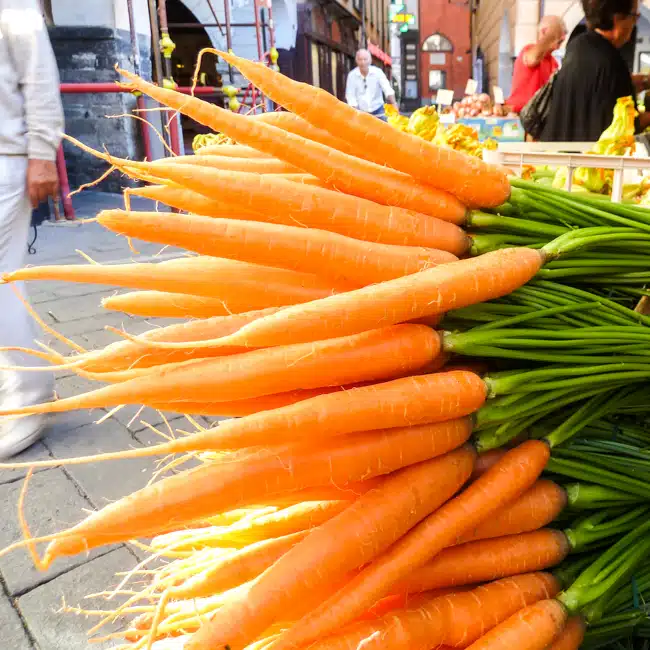
🥦 Fresh Vegetables
Fruits and vegetables aren't traditionally considered pantry items. But there are a few that I recommend always having on hand. The below foods can be used in a bazillion ways, and last a long time if properly store. This is particularly true for root vegetables.
Use the search function on this blog to find the abundance of recipes using these simple vegetables.
Cauliflower
Sweet potatoes and white potatoes
Broccoli
Onions and Garlic
Cabbage
Red Bell Peppers and Poblano Peppers
Carrots
Butternut Squash (when in season)

🍳 Eggs
I buy exclusively eggs that are organic from pasture-raised chickens to maximize the nutritional content of the eggs. Pasture-raised means the chickens roam on pastures, feeding naturally on seeds, bugs, and grasses.
Eggs are packed with protein and offer a way to turn vegetables into a meal. But making quiche, egg bakes, huevos rancheros, or a quick egg salad are also great ways to incorporate eggs into a vegetarian diet. (The huevos rancheros recipe won first prize in a nationwide recipe development contest!)
Do Vegetarian Diets Include Eggs?
The short answer is yes, eggs are included in a vegetarian diet but never included in a vegan diet, which eliminates all animal products.
The longer answer is that there are different types of vegetarian diets. Some people who follow a vegetarian diet do not allow eggs. Here are the primary vegetarian diets:
Lacto-Ovo-Vegetarian
Lacto-ovo-vegetarians eliminate all meat, poultry, seafood, and any by-products that require animal slaughter. They consider it acceptable to eat animal by-products like dairy and eggs as long as the animals producing them are well-treated.
Lacto-Vegetarian
Lacto-vegetarians exclude meat, poultry, seafood, and eggs from their diet but include dairy products like milk, cheese, yogurt, and butter.
Ovo-Vegetarian
Ovo-vegetarians exclude meat, poultry, seafood, and dairy from their diet but include eggs and egg-containing foods.

mjskitchen
I had never heard of pulses Now I know. Even though we're not vegetarian, more flexitarian, I think, your pantry and mine soiund pretty much the same. I don't have the variety of grains, more a large variety of different types of rice We love rice. 🙂 the glass jars are a must for long term storage. You probably don't remember, but back in the 70's Paul Masson bottled its wine in semi-wide mouth jars with usable lids. Back then I started using them to store flours and rice and still have a few of those jars today. 🙂 Costco sells peach slices in jars and those are great for storing my never ending supplies of dried beans, Great article Susan! Hope you are staying safe and well.
The Wimpy Vegetarian
Thank you so much MJ. We love rice too - and I have a bunch of different types, and I have quinoa. That's about it for grains. I have a whole drawer in the kitchen just for my empty jars, lol. Those wine bottles sound perfect for storing staples! We're doing well - it's a little stressful - but we're doing fine. I hope you are too! So great to hear from you!
Joelle
This is exactly what I was looking for; any specific spices to have on hand?
Also I have heard of chia and flaxseeds are they also a staple to have on hand?
Our family did a challenge for the month of February to go vegetarian and it worked
I am staying vegetarian but both my husband and son are going back to eating meat.
So I will be in your boat, having side dishes for me while including meat products for my husband.
Your suggestion to plan ahead and know what you are cooking is on point, this past week nothing was planned
so we ended up eating out - pasta 3 nights in a row, with soups and salads to round us out. I will be heading to the store today.
The Wimpy Vegetarian
I've totally done that, lol!!! Hello, take-out!!! Many congrats to you on decided to forge ahead with going vegetarian. It's a journey, particularly when the whole family doesn't follow us.
As for spices, I particularly like spices that add a smoked flavor since it triggers the umami button in our mouths. Smoked paprika and chipotle powder are always in my spice cabinet. My favorite smoked paprika products are Hungarian paprika (both hot and sweet) and a Spanish version called Pimeton de la Vera. McCormick's has a chipotle pepper spice powder that I also like. Chipotle spice is spicy. If you don't want spicy, but want smoke / depth of flavor, Aleppo pepper flakes is a great option. Hope this helps!!!
Dan P
I'm glad I found this site. I am moving towards vegetarian-based diet at age 60. I've been on it for just about 2 weeks and feel the difference already. Looking forward to checking out all your recipes.
Susan Pridmore
Hi Dan, Welcome! And all the best to you in your journey. I hope you find recipes here you want to try, and information to support you!